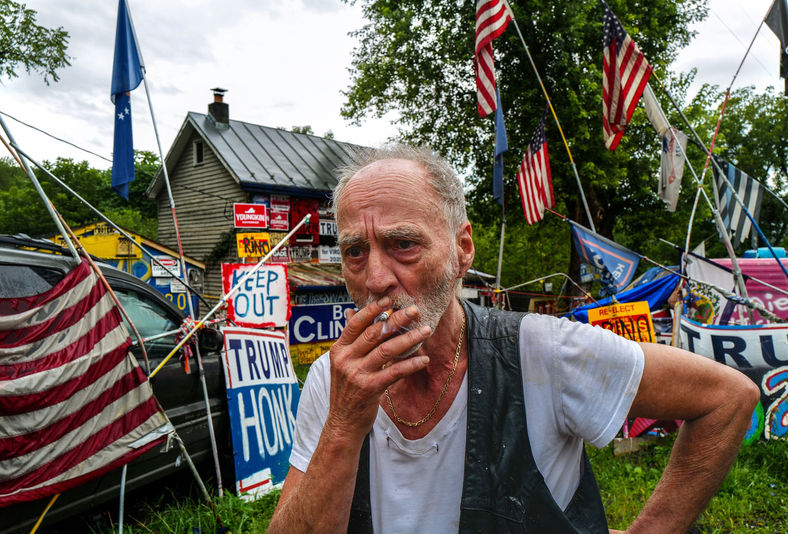

THE AMERICA ISSUE
Fall 2022
Published by the Social Documentary Network
VIEW CONTENTS or PREVIOUS | NEXT
ZEKE home page | Subscribe
America Issue portfolios 10-18
White Nationalism
Anthony Karen
While documenting an ongoing project on the Ku Klux Klan, I came in contact with several organizations within the White nationalist movement. I’ve had the unique opportunity to photograph many of these groups without restriction over the past thirteen years and I will continue to do so for the long-term. The following images are a look into their private and social lives. View more images on the SDN website.
Has Godot Arrived?
Eric Chang
In Samuel Beckett’s play, Waiting for Godot, the main characters wait endlessly by the side of a road for Godot to arrive. Perhaps they are waiting because his presence will give meaning to their lives? Has Godot arrived in the form of Trump for many of his followers? This personal project was undertaken in an attempt to answer this question by creating a relationship with one of Trump’s passionate followers, Tommy Smith from Edinburg, Virginia, and thereby understanding more broadly what motivates his followers to believe Trump’s lies. View more images on the SDN website.
Sex Trafficking: An American Story
Matilde Simas
When people hear that someone was trafficked, it’s often assumed they were kidnapped and forced into labor against their will. Trafficking can be much more insidious. People are often exploited by someone they already know.
In this photo documentary, we listen to the story of Cary Stuart, an American survivor of forced commercial sexual exploitation, who was lured into the world of trafficking by a romantic partner or “Romeo Pimp.” In the series, she reflects on her experience, the way it has impacted her mental state, and the ongoing challenges of working through drug addiction. Addiction to drugs can be both a vulnerability to trafficking, and a common tactic used by traffickers to make victims more compliant.
While the prevalence of sex trafficking in the U.S. is still unknown, we do know that women, children, and men are being sold for sex against their will in all 50 states. In 2014, the Urban Institute studied the underground commercial sex economy in eight U.S. cities and estimated that this illicit activity generated between $39.9 million and $290 million in revenue depending on the city. View more images on the SDN website.
Working Ohio
Steve Cagan
Living in Cleveland, I’ve witnessed the dramatic decline of what was a major industrial center, where thousands of people worked in good-paying, secure jobs, creating, building, and producing through physical and mental strength. That is largely—but not entirely—gone.
Today, the media talks about trying to recover jobs lost during the pandemic. Jobs lost between the 1970s and early 21st century aren’t even discussed any more.
And those people who still work in Cleveland in union jobs—in what remains of our industry—are unseen and unappreciated by the media and the art world.
We documentarians must present people not only as victims of social problems, but also as strong, creative, resistant—which in fact they are. View more images on the SDN website.
Working the Harvest in California
David Bacon
A multi-level portrait of a working-class community, Yakima, in central Washington state, revealing its human face of work and poverty. Images explore the geography of its barrios and workplaces, both the closed factory of Yakima’s past and the agricultural fields of its present.
Originally intending to photograph farm workers, I wanted to show other dimensions of the Latino community, including houses and trailers, a closed plywood mill, a homeless encampment, and guest worker camps.
One older man who came to the U.S. as a bracero and worked as a farm worker for many years was collecting cans for recycling to have enough money to eat. Photographing his hands is a tribute to all the work reflected there, and to the working people of Yakima. View more images on the SDN website.


An American Dance
Brian Branch-Price
Dancing in the Black experience transcends across the world from Duke Ellington’s swing to break dancing in the upcoming 2024 Olympics.
The images displayed are an ongoing project from my “Blacana” project. The opening set is from a stoop in Harlem, followed by New Jersey House Music, followed by a Juneteenth Celebration at American Dream and Hartz Plaza in Detroit. I invite all my photo friends to explore our dance culture. If you’re nearby one of the places, stop and make a story of it. View more images on the SDN website.
American Punk as an American Mosaic
Daniel Hoffman
The idea of “America” has evolved and changed since 1959 when Robert Frank published his seminal work. While America is less homogeneous now than ever before, it is no less fraught with social challenges to understand what it means to be “American.” However, sitting on the margins of our society is a group of Americans who form a community that celebrates ideals central to being “American,” the American Punks.
In their music and dance, punks celebrate life, mutual trust and support, and freedom to express themselves about social injustice and the government. Indeed, American Punks form a dynamic example of the “American Mosaic.” American Punks come from all sectors of society and often include immigrants, all are welcome provided you are free of bias and judgement. E Pluribus Unum.
This project explores the idea of American Punks as a social movement that embodies what it means to be American. View more images on the SDN website.


First Nations: Portraits of Dancers and Wisdom Keepers
Jeanny Tsai
Historically, Indigenous Americans have largely been portrayed in unfavorable stereotypes in the media and their presence has been mostly invisible in education, pop culture, and politics in the U.S.
Currently, there are 574 federally recognized Indigenous American Nations. I estimate I have photographed individuals from over 60 Nations from the U.S. and Canada so far. I have traveled to numerous intertribal gatherings around the U.S. to meet and photograph First Nations dancers and wisdom keepers. Through this photo series, I seek to illuminate these contemporary Indigenous Americans who are simultaneously preserving and evolving their traditions.
I was inspired to start this portrait series during the Standing Rock Reservation protests against the Dakota Access Pipeline in 2016 because I wanted to know more about the Indigenous traditions in the U.S. As a young person attending public school, I feel I received a limited education about the history of Indigenous Americans. As I worked on this series, I heard many personal stories told to me by the people I photographed. In turn, I captured their stories that are not spoken but are told through the radiance of their eyes and spirit. View more images on the SDN website.
Good Earth
Esha Chiocchio
Good Earth celebrates New Mexican agrarians who are revitalizing land through regenerative practices—building soil, sequestering carbon, reducing toxins, and improving the health of people, plants and animals.
To better understand the range of regenerative techniques being employed, podcast host Mary-Charlotte Domandi and photographer Esha Chiocchio used interviews and photography to document the techniques of Native American land managers, farmers, composters, ranchers, goat herders, orchardists, and soil scientists to improve the foundation of society: soil. This series provides a window into regenerative land stewardship and demonstrates how we can all play a role in rehabilitating the good earth. View more images on the SDN website.



ZEKE magazine is published by the Social Documentary Network (SDN)
info@socialdocumentary.net | www.socialdocumentary.net
SDN and ZEKE magazine are projects of Reportage International Inc., a nonprofit organization incorporated in Massachusetts in 2020.














































